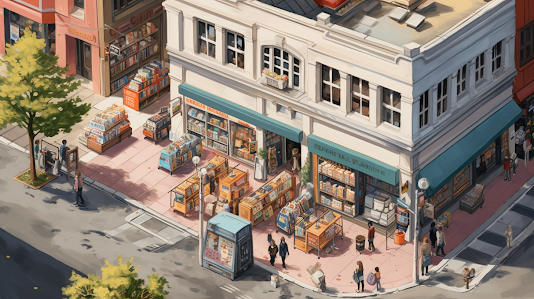Serenade of Silence
The short fictional story, which was generated with AI, as the images (sorry for inconsistency).
Part I: The Silence Falls
Amelia had always been an oddity in the bustling city of Crescendo. She cherished the quiet moments, the hushed whispers of books, and the soft rustle of pages turning in her beloved bookstore, "The Quill's Hush." In a world where noise was currency, Amelia was a pauper, content with the wealth of words and solitude.
Crescendo was a metropolis of cacophony, where streets echoed with the symphony of life. Conversations intertwined with the melodies of street musicians, and laughter danced in harmony with car horns. The city's heart pulsed to the rhythm of sound.
Amelia's haven was a sanctuary from the discord. Her bookstore was a tapestry of tales, its shelves filled with words that painted pictures and whispered secrets. She spent her days among the pages, relishing the conversations between authors and characters, each voice carrying a distinct timbre.
One fateful morning, as Amelia was arranging her books with meticulous care, a strange sensation gripped her. She froze, her heart pounding in her chest. It was as if a giant hand had reached into the city and plucked sound from its very core. A sudden hush descended upon Crescendo.
Amelia emerged from her bookstore, eyes wide with bewilderment. The bustling streets had turned into a silent tableau. People gesticulated wildly, their mouths moving, but no sound escaped. Panic rippled through the crowd like a silent earthquake.
She spotted her friend, Sarah, who worked at the nearby café. Sarah's lips formed words, but only silence flowed from them. She looked at Amelia, her eyes pleading for an answer they couldn't speak.
Amelia's heart ached for the loss of sound. It was as if a storm had swept away the city's soul, leaving behind a desolate calm. She ventured further into the muted streets, absorbing the eeriness of this new world.
Days turned into weeks, and the city adapted to its soundless existence. People communicated through gestures, writing, and the language of expressions. Amelia, who had always found solace in silence, found herself struggling to adapt.
In "The Quill's Hush," her beloved books sat like silent witnesses to this new era. Their words held no comfort when there was no laughter, no shared stories, no music to accompany them. The city had become a vast, soundless library, and Amelia, ironically, felt isolated in the very silence she had once cherished.
As the days passed, questions loomed over Crescendo like a gathering storm. What had caused this abrupt silence? Would sound ever return, or were they destined to live in this muted world forever? And in this newfound quietude, would they discover a deeper understanding of the significance of sound in their lives?
Amelia, too, grappled with these questions, her heart heavy with the realization that perhaps, in the absence of sound, the world had become a stranger to her.
Part II: The Silent Chorus
In the months that followed the inexplicable disappearance of sound, Crescendo transformed. The city once known for its raucous symphony had become a realm of muted wonders and hushed mysteries.
Amelia, still working diligently in “The Quill’s Hush,” watched as her customers adapted to this new reality. People browsed the shelves with an air of reverence, selecting books as if they were searching for the missing melodies of their lives.
Sarah, her dear friend from the café, visited often. They communicated through writing and shared their thoughts on scraps of paper. But as the days turned into weeks and the weeks into months, their conversations became more somber. They spoke of the beauty they had once found in the city’s noise, the music that had accompanied their daily lives.
One evening, Amelia noticed a gathering at the city’s central square. A makeshift stage had been set up, and a group of performers stood ready to entertain the crowd with a silent play. As the curtains rose, the actors moved gracefully, their movements a choreographed dance of emotion. The audience was captivated, their faces reflecting a spectrum of feelings in the absence of spoken words.
Amelia was struck by the power of this new form of expression. The performers conveyed stories, emotions, and ideas solely through movement and expression. It was as if they had unlocked a hidden dimension of communication, one that transcended the need for sound.
She watched as the city embraced this newfound art, transforming into a place where silence wasn’t an absence but a canvas on which to paint their feelings and dreams. Crescendo had become a city of mime, dance, and visual storytelling.
One day, Amelia met a man named Luca, a skilled painter who had turned to the city’s silent landscape for inspiration. He showed her his canvases, each a riot of colors and emotions that danced on the page. In his eyes, Amelia saw a reflection of her own longing for the return of sound.
As their friendship grew, Luca introduced Amelia to a secret society of artists who believed that sound had not abandoned them but had merely taken on a new form. They called themselves “The Silent Chorus,” and their mission was to explore the uncharted territories of silence.
Amelia joined their ranks, drawn by their determination to preserve the city’s creative spirit. Together, they painted, danced, and crafted stories in the absence of spoken words, weaving a tapestry of expression that transcended the boundaries of sound.
Part III: A Symphony Reborn
The city of Crescendo had become a living paradox — a place where silence had birthed new forms of expression, where words remained unsaid yet understood, and where the absence of sound had paradoxically amplified the emotions of its inhabitants.
Amelia had fully embraced her role in “The Silent Chorus,” working alongside Luca and other passionate artists to create a vibrant tapestry of silent storytelling. As their performances and exhibitions garnered acclaim, the world outside began to take notice. Visitors from neighboring cities arrived, curious to witness the enigmatic charm of Crescendo’s soundless culture.
But even as the city thrived in its newfound artistic renaissance, a quiet yearning persisted in every heart. The absence of sound was an absence of connection, and the people of Crescendo longed to hear the voices of loved ones, the laughter of children, and the melodies that had once defined their lives.
One evening, as the members of “The Silent Chorus” prepared for a grand performance in the heart of the city, an extraordinary phenomenon unfolded. A soft hum, barely audible, swept through the air like a gentle breeze. The members exchanged puzzled glances, their hearts quickening with anticipation.
As they took the stage, they began their silent performance, moving with the grace and fervor that had come to define Crescendo’s silent arts. But something had changed. The air was charged with a peculiar energy, and their movements seemed to resonate with an invisible force.
As if guided by an unseen hand, Amelia danced, Luca painted, and the entire ensemble conveyed stories with a depth of emotion they had never before experienced. It was as though the city itself was lending them its voice, and their silent expressions were now imbued with a profound resonance.
In the midst of this mesmerizing performance, the impossible happened — the city began to sing. It started with a faint, ethereal melody that echoed through the streets, building in strength and complexity. Crescendo’s architecture, long dormant in its role as a vessel for sound, reverberated with newfound life.
The people in the audience gasped as their voices returned, and their joyous exclamations filled the air. Tears flowed freely as friends and family members embraced, their laughter and shared words weaving a symphony of reunion.
Amelia and Luca, caught in the rapture of the moment, shared a smile that spoke volumes. They had found a way to celebrate the return of sound without abandoning the art they had created in its absence. The city had been reborn, its soul reawakened with a newfound appreciation for the significance of sound in their lives.
In the days that followed, the city of Crescendo found harmony in both sound and silence. The streets once again echoed with laughter, music, and conversation, but they also embraced the silent arts that had flourished during the time of quietude.
Amelia continued to run “The Quill’s Hush,” now a haven for those seeking the solace of words and the serenity of silence. Luca’s paintings gained even greater acclaim, capturing the essence of Crescendo’s unique journey.
As the city embraced its newfound duality, it became a place where the beauty of sound and the power of silence coexisted, each enhancing the other in a symphony of life.
Crescendo had learned that silence, once feared, could be a canvas for creativity and reflection, and sound, once taken for granted, could be a precious gift to cherish. And in the interplay of these two worlds, they had discovered a deeper understanding of themselves and the intricate tapestry of human connection.













Комментарии
Отправить комментарий